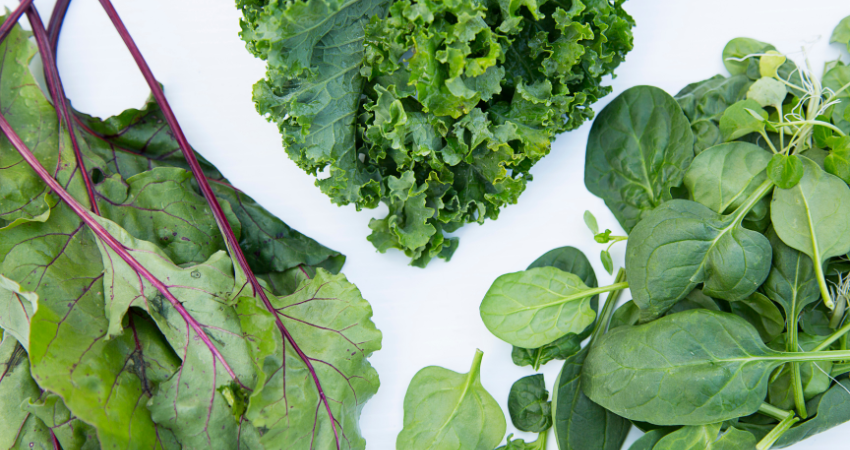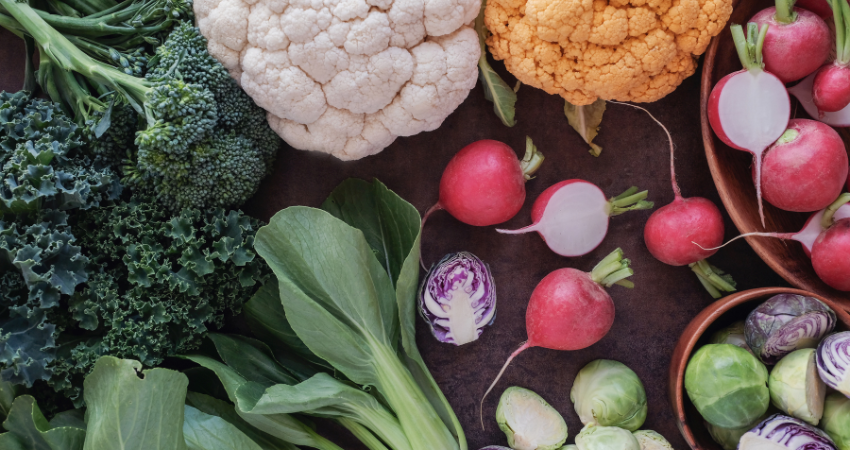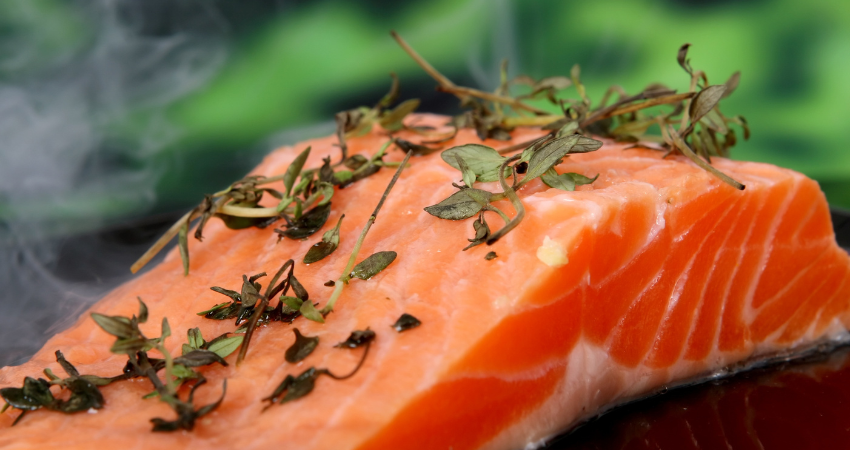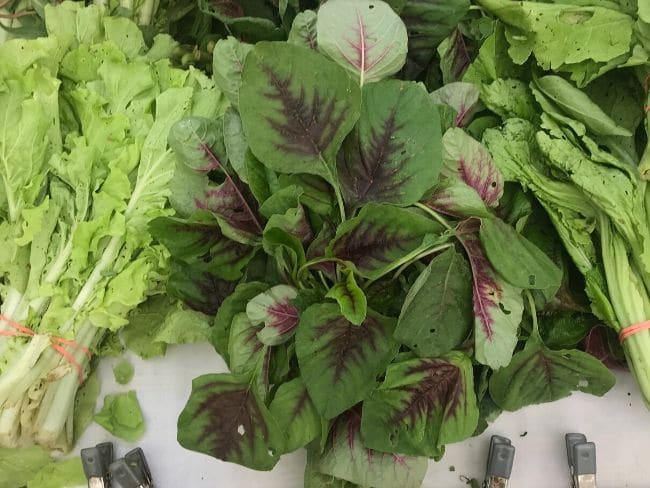The Big 3 | Eat More
Eating more of the following foods is key to supporting your breast health.
1. Organic Leafy Greens

Leafy greens are a rich source of vitamins, like mood-balancing folate; hard-to-get minerals, like magnesium; high in fiber and phytonutrients. Lettuce greens, from mesclun and Bibb, to red leaf and butter lettuces, are high in water and a good source of folate and vitamins A and K. Dark leafy greens, like spinach, kale, romaine, green and red leaf lettuce, mustard greens, chicory, and Swiss chard, are rich in fiber, folate and carotenoids.
A higher consumption of leafy green vegetables was associated with a lower risk of estrogen receptor-negative (ER-) breast cancer in an analysis of 20 observational human studies (46).
What you may not know… Nearly 75% of conventionally grown produce sold in the U.S. contains pesticide residues. Any type of leafy green, including salad greens, is highly suspect. Spinach is #2, and kale, collard and mustard greens tie for #3 on the Environmental Working Group’s 2023 Dirty Dozen ranking of pesticide residue-contaminated produce.
In 2016, the USDA collected 642 conventional spinach samples for a pesticide analysis. What they found: each spinach sample contained, on average, 7 pesticides—with a maximum of 19 different pesticides on a single sample. Seventy-six percent of the samples contained permethrin, a neurotoxic insecticide, which, at high doses, affects the nervous system and can cause tremors and seizures (47). A study published in Environmental Health found that children with detectable permethrin levels in their urine were twice as likely to be diagnosed with ADHD (48).
Kale is another high pesticide residue leafy green. Multiple samples of conventionally grown kale indicated 18 different pesticides. And, nearly 60% of conventionally grown kale samples sold in the U.S. were sprayed with DCPA (or “Dacthal”), a pesticide classified as a potential carcinogen in 1995 (49).
In addition to kale, more than 35 percent of collard greens and mustard green samples analyzed by the USDA in 2019 contained detectable levels of DCPA (50).
You want to eat leafy greens to prevent cancer—not to increase your risk of getting it! It really is worth choosing organic.
Support breast health: Buy organic leafy greens! Try incorporating raw and/or cooked leafy greens at most meals. In addition to salads, drink your greens in green juices, or add 1 or 2 large handfuls to smoothies. Aim to eat 8 to 12 servings daily. For recipe inspiration, click here and here. Try a DIY 7 Day Body Reset Cleanse as a way to introduce more greens into meals. Bolster your immune system with this nutrient-dense greens powder, which provides nutrient, antioxidant and detoxification support.
2. Cruciferous Vegetables

Research shows that regularly eating cruciferous vegetables is associated with lower breast cancer risk.
Cruciferous vegetables are in the brassica family: broccoli, cabbage, cauliflower, Brussels sprouts, turnip, rutabaga and radis). Cruciferous leafy greens include arugula, collard greens, mustard greens, bok choy, watercress and many varieties of Asian greens.
Why do they have such potent anti-cancer protective effects?
Cruciferous vegetables are a nutrition powerhouse: a rich source of vitamins C, E, K; folate; minerals; antioxidants; flavonoids; and high in fiber. They also contain glucosinolates, sulfur-containing chemicals, that give cruciferous vegetables their distinct, pungent smell and bitter taste. Glucosinolates also help the liver produce detoxifying enzymes.
When you chop, chew and digest cauliflower, the glucosinolates break down into biologically active compounds—indoles, nitriles, thiocyanates, and isothiocyanates (ICTs)—that prevent cancer cell growth. Laboratory studies have found that indoles and ICTS can prevent cancer in the breast (as well as other organs) in mice and rats (51).
What about humans? A study of 337 Chinese women found that those who ate the most cruciferous vegetables had significantly reduced breast cancer risk (52).
Your liver and your gut play important roles in helping your body get rid of extra (bad) estrogen. Your liver converts estrogen into metabolites that are excreted through the kidneys and gut. Your estrogen is also “packaged” in your liver, so that it can exit (in bile) via your poop. Eating cruciferous vegetables helps your liver perform more efficiently.
Support breast health: Eating fiber-rich foods every day—especially cruciferous vegetables and leafy greens—helps promote healthy bowel movements. You need to poop every day in order to get rid of excess (harmful) estrogen. You want to be in a state of estrogen balance, NOT estrogen dominance, which can contribute to increased breast cancer risk. Eat a minimum of 3 to 5 servings of cruciferous vegetables per week. Recipes for my favorite cruciferous-themed dishes are here. You can also try reaping the benefits of cruciferous (sulforaphane glucosinolate) in a capsule; I like this one as it supports liver detoxification.
3. Wild-caught fish and fish oil

Chronic inflammation is linked with breast cancer development, its metastasis (spreading), recurrence, and lower survival rates. Being overweight or obese creates an environment that encourages chronic inflammation, insulin resistance and an overproduction of estrogen in the body (53, 54).
A nutrient that can help fight chronic inflammation? Omega-3 fatty acids. They help reduce the production of substances that promote inflammation, like inflammatory cytokines. Higher omega 3 intake has consistently been linked with lower inflammation levels—and with reduced risk of breast cancer in women (55).
Not all omega-3 fatty acids are created equal. Alpha linolenic acid (ALA), a plant-based omega 3 fatty acid, is found in soy, canola oil, flax seed, chi seeds and walnuts. In order for your body to use it, ALA has to first be converted into eicosapentaenoic acid (EPA) and docosahexaenoic acid (DHA)—and this conversion process is very inefficient.
Wild-caught fish, like salmon, mackerel and sardines naturally contain the anti-inflammatory omega-3 fatty acids, EPA and DHA. Studies suggest that omega 3 fatty acids—from fish and fish oil—are more effective in preventing breast cancer than plant-based omega 3 fatty acid.
In a 2018 study, researchers compared the effects of three types of omega 3s—ALA, DHA and EPA—on breast tumor development in mice bred to develop breast cancer that was HER2-positive (this is an aggressive form of breast cancer that tests positive for a protein called Human Epidermal Growth Factor Receptor 2). Mice exposed to fish-derived omega 3s (EPA and DHA) experienced a 60-70% reduction in tumor size and 30% less breast tumors. When the same dose of plant-based ALA was given to mice, it did not have the same protective effect against breast cancer tumors; it was only 1/8 as potent as DHA and EPA. Researchers concluded that fish oil-based DHA and EPA omega 3s were 8 times more effective than ALA in preventing the growth of breast cancer tumors (56).
Support breast health: Eat 12 to 16 ounces of wild-caught, cold water, fatty fish (like salmon, sardines, cod or mackerel) every week. Some of home-cooked favorite fish preparations are here. Supplement with high quality fish oil capsules or a high quality (liquid) fish oil. I like both.
Continue Reading About Breast Cancer Prevention (below):
Your Breasts: What You Need to Know (Part 1)
Understanding Estrogen: How It Affects Breast Health (Part 2)
Protect Your Breasts: Avoid / Limit the Big 3 (Part 3)
Sources
46 American Institute for Cancer Research (AICR). AICR Food Facts. April 6, 2021.
47 Environmental Working Group (EWG).
48 Wagner-Schuman M, Richardson JR, Auinger P, Braun JM, Lanphear BP, Epstein JN, Yolton K, Froehlich TE. Association of pyrethroid pesticide exposure with attention-deficit/hyperactivity disorder in a nationally representative sample of U.S. children. Environ Health. 2015 May 28;14:44.
49, 50 Environmental Working Group (EWG).
51 National Cancer Institute.
52 Cancer Research. 2003. July 15; 63(14):3980-6
53 Am Soc Clin Oncol Educ Book. 2013; 33: 46–51
54 Journal of Clinical Oncology. 2009
55 Breast Cancer Research. 17, Article number: 62 (2015)
56 Journal of Nutritional Biochemistry. Vol. 55. May 2018, Pages 41-52


